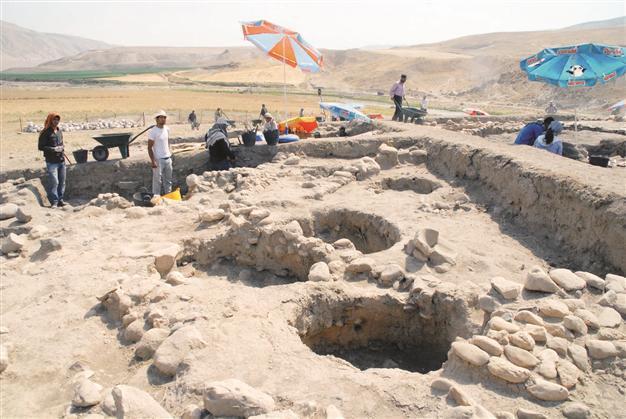Bones from Neolithic era found in Turkey's Hasankeyf
BATMAN - Doğan News Agency

Excavations have revealed human skeletons buried underground. The skeletons date back to the Neolithic age 11,500 years ago, according to Japanes Professor Yutuka Miyake. DHA photo
Excavations carried out by a Japanese team in Batman’s ancient city of Hasankeyf have revealed painted graves from the Neolithic age 11,500 years ago. Human skeletons were found in the graves. Hasankeyf attracts 500,000 visitors from all around the world each year, yet part of Hasankeyf’s historical area will be flooded once the Ilısu Dam project starts.The head of the Hasankeyf excavation team, Batman University Rector Abdüsselam Uluçam, said that a tender had been put out for the movement of Hasankeyf to a new place.
He added that Hasankeyf should move to its new place as soon as possible and it was out of question for the ancient city to be submerged underwater before the end of movement process.
“I have been continuing excavation works here for some 12 years. All public owned land has been excavated in Hasankeyf. We can continue excavations on privately-owned lands when the State Hydraulic Works (DSI) confiscates them. The movement works have been put out to tender. The movement of 15 artifacts will begin soon. Also, the castle rocks should be protected from the water. Otherwise the castle rocks will collapse. Hasankeyf Bridge will remain underwater. We will only move the Seljuk reliefs at the foot of the bridge,” Uluçam said.
He said that shanty houses, which were built in 1966 and where the people of Hasankeyf were living, should be removed in order to reveal the whole of the ancient city.
Village from Neolithic age
This year 18 painted graves from the Neolithic age were discovered in the Hasankeyf tumulus. Works are still continuing with 12 experts, six students and 40 workers under the scientific consultation of Japanese Tsukuba University’s Professor Yutuka Miyake.
Miyake said that the tumulus were from 11,500 years ago, the beginning of the Neolithic age, and continued:
“We know this place as the first village founded in the region. People lived the nomadic life here. Sometime later they moved to settled life. There are lots of rounded houses here and people lived there. There is a structure of 9 meters in width. We think that this structure is a special one. There is an obelisk on the floor. We have found the same thing in a tumulus in Siirt. We determined 30 funerary chambers and human skeletons underground. In these times, people used to be buried underground because there were no graveyards. We also found traces of painting on human skeletons. The bones were painted with orange and black.”
Miyake said that excavations started on Aug. 15 and 18 human skeletons had been found since then. The number of total human skeletons found amounted to 80 when added to those found last year.
















